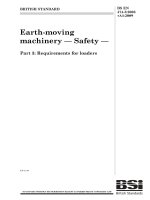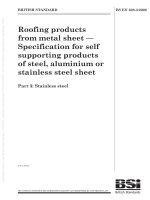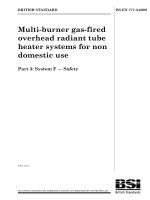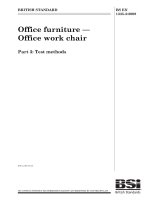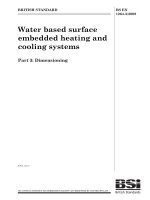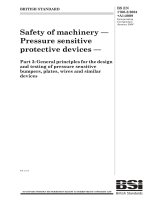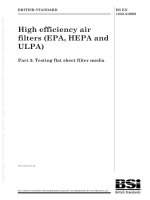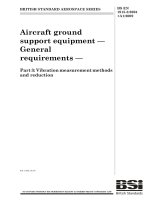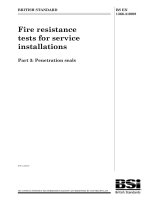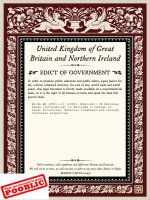Bsi bs en 60332 3 10 2009
Bạn đang xem bản rút gọn của tài liệu. Xem và tải ngay bản đầy đủ của tài liệu tại đây (223.81 KB, 23 trang )
Licensed Copy: athen reading, Reading University Library, 23/01/2010 05:11, Uncontrolled Copy, (c) BSI
BS EN 60332-3-10:2009
BSI Standards Publication
Tests on electric and optical fibre
cables under fire conditions
Part 3-10: Test for vertical flame spread of verticallymounted bunched wires or cables — Apparatus
NO COPYING WITHOUT BSI PERMISSION EXCEPT AS PERMITTED BY COPYRIGHT LAW
raising standards worldwide™
BRITISH STANDARD
Licensed Copy: athen reading, Reading University Library, 23/01/2010 05:11, Uncontrolled Copy, (c) BSI
BS EN 60332-3-10:2009
National foreword
This British Standard is the UK implementation of EN 60332-3-10:2009. It is
identical to IEC 60332-3-10:2000, incorporating amendment 1:2008.
It supersedes BS EN 50266-1:2001 which is withdrawn.
The start and finish of text introduced or altered by amendment
is indicated in the text by tags.Tags indicating changes to IEC
text carry the number of the IEC amendment.For example,text
altered by IEC amendment 1 is indicated by !" .
The UK participation in its preparation was entrusted by Technical Committee
GEL/20, Electric cables, to Subcommittee GEL/20/18, Fire testing.
A list of organizations represented on this subcommittee can be obtained on
request to its secretary.
This publication does not purport to include all the necessary provisions of a
contract. Users are responsible for its correct application.
© BSI 2010
ISBN 978 0 580 66767 1
ICS 29.060.20; 13.220.40; 29.020; 33.180.10
Compliance with a British Standard cannot confer immunity from
legal obligations.
This British Standard was published under the authority of the
Standards Policy and Strategy Committee on 31 January 2010
Amendments/corrigenda issued since publication
Amd. No.
Date
Text affected
Licensed Copy: athen reading, Reading University Library, 23/01/2010 05:11, Uncontrolled Copy, (c) BSI
BS EN 60332-3-10:2009
EUROPEAN STANDARD
EN 60332-3-10
NORME EUROPÉENNE
October 2009
EUROPÄISCHE NORM
ICS 29.060.20, 13.220.40; 29.020
Supersedes EN 50266-1:2001 + corr. March 2002
English version
Tests on electric and optical fibre cables under fire conditions Part 3-10: Test for vertical flame spread
of vertically-mounted bunched wires or cables Apparatus
(IEC 60332-3-10:2000 + A1:2008)
Essais des câbles électriques
et des câbles à fibres optiques
soumis au feu Partie 3-10: Essai de propagation verticale
de la flamme des fils ou câbles
montés en nappes en position verticale Appareillage
(CEI 60332-3-10:2000 + A1:2008)
Prüfungen an Kabeln, isolierten Leitungen
und Glasfaserkabeln im Brandfall Teil 3-10: Prüfung der vertikalen
Flammenausbreitung von vertikal
angeordneten Bündeln von Kabeln
und isolierten Leitungen Prüfvorrichtung
(IEC 60332-3-10:2000 + A1:2008)
This European Standard was approved by CENELEC on 2009-08-01. CENELEC members are bound to comply
with the CEN/CENELEC Internal Regulations which stipulate the conditions for giving this European Standard
the status of a national standard without any alteration.
Up-to-date lists and bibliographical references concerning such national standards may be obtained on
application to the Central Secretariat or to any CENELEC member.
This European Standard exists in three official versions (English, French, German). A version in any other
language made by translation under the responsibility of a CENELEC member into its own language and notified
to the Central Secretariat has the same status as the official versions.
CENELEC members are the national electrotechnical committees of Austria, Belgium, Bulgaria, Cyprus, the
Czech Republic, Denmark, Estonia, Finland, France, Germany, Greece, Hungary, Iceland, Ireland, Italy, Latvia,
Lithuania, Luxembourg, Malta, the Netherlands, Norway, Poland, Portugal, Romania, Slovakia, Slovenia, Spain,
Sweden, Switzerland and the United Kingdom.
CENELEC
European Committee for Electrotechnical Standardization
Comité Européen de Normalisation Electrotechnique
Europäisches Komitee für Elektrotechnische Normung
Central Secretariat: Avenue Marnix 17, B - 1000 Brussels
© 2009 CENELEC -
All rights of exploitation in any form and by any means reserved worldwide for CENELEC members.
Ref. No. EN 60332-3-10:2009 E
Licensed Copy: athen reading, Reading University Library, 23/01/2010 05:11, Uncontrolled Copy, (c) BSI
BS EN 60332-3-10:2009
EN 60332-3-10:2009
–2–
Foreword
The text of the International Standard IEC 60332-3-10:2000 and its amendment A1:2008, prepared by
IEC TC 20, Electric cables, was submitted to the Unique Acceptance Procedure and was approved by
CENELEC as EN 60332-3-10 on 2009-08-01 without any modification.
This European Standard supersedes EN 50266-1:2001 + corrigendum March 2002.
The following dates were fixed:
– latest date by which the EN has to be implemented
at national level by publication of an identical
national standard or by endorsement
(dop)
2010-08-01
– latest date by which the national standards conflicting
with the EN have to be withdrawn
(dow)
2012-08-01
Annex ZA has been added by CENELEC.
__________
Endorsement notice
The text of the International Standard IEC 60332-3-10:2000 and its amendment A1:2008 was
approved by CENELEC as a European Standard without any modification.
__________
Licensed Copy: athen reading, Reading University Library, 23/01/2010 05:11, Uncontrolled Copy, (c) BSI
BS EN 60332-3-10:2009
–3–
EN 60332-3-10:2009
Annex ZA
(normative)
Normative references to international publications
with their corresponding European publications
The following referenced documents are indispensable for the application of this document. For dated
references, only the edition cited applies. For undated references, the latest edition of the referenced
document (including any amendments) applies.
NOTE Where an International Publication has been modified by common modifications, indicated by (mod), the relevant
EN/HD applies.
Publication
Year
Title
EN/HD
Year
IEC 60695-4
-
1)
Fire hazard testing Part 4: Terminology concerning fire tests
EN 60695-4
2006
IEC Guide 104
-
1)
The preparation of safety publications and
the use of basic safety publications and
group safety publications
-
-
———————
1)
Undated reference.
2)
Valid edition at date of issue.
2)
Licensed Copy: athen reading, Reading University Library, 23/01/2010 05:11, Uncontrolled Copy, (c) BSI
BS EN 60332-3-10:2009
–4–
60332-3-10 © IEC:2000+A1:2008
CONTENTS
INTRODUCTION .....................................................................................................................5
1
Scope ...............................................................................................................................6
2
Normative references........................................................................................................6
3
Definitions ........................................................................................................................6
4
Test environment ..............................................................................................................6
5
Test apparatus .................................................................................................................7
6
5.1 Test chamber ..........................................................................................................7
5.2 Air supply ................................................................................................................7
5.3 Ladder types............................................................................................................7
5.4 Effluent cleaning attachment ....................................................................................7
Ignition source ..................................................................................................................8
6.1
6.2
Type ........................................................................................................................8
Positioning...............................................................................................................9
Annex A (informative)
Details of recommended burner ........................................................ 18
Annex B (informative)
Flowmeter calibration correction factors ............................................ 19
Figure 1 – Test chamber ....................................................................................................... 11
Figure 2 – Thermal insulation of back and sides of the test chamber...................................... 12
Figure 3 – Positioning of burner and typical arrangement of test sample on ladder ................. 13
Figure 4 – Tubular steel ladders for cable test ....................................................................... 14
Figure 5 – Burner configurations............................................................................................ 15
Figure 6 – Arrangement of holes for burners.......................................................................... 16
Figure 7 – Schematic diagram of an example of a burner control system using rotameters..... 17
Licensed Copy: athen reading, Reading University Library, 23/01/2010 05:11, Uncontrolled Copy, (c) BSI
BS EN 60332-3-10:2009
60332-3-10 © IEC:2000+A1:2008
–5–
INTRODUCTION
Parts 1 and 2 of IEC 60332 specify methods of test for flame spread characteristics for a single
vertical insulated wire or cable. It cannot be assumed that, because a wire or cable meets the
requirements of parts 1 and 2, a vertical bunch of similar cables or wires will behave in a
similar manner. This is because flame spread along a vertical bunch of cables depends on a
number of features, such as
a) the volume of combustible material exposed to the fire and to any flame which may be
produced by the combustion of the cables;
b) the geometrical configuration of the cables and their relationship to an enclosure;
c) the temperature at which it is possible to ignite the gases emitted from the cables;
d) the quantity of combustible gas released from the cables for a given temperature rise;
e) the volume of air passing through the cable installation;
f)
the construction of the cable, for example armoured or unarmoured, multi- or single-core.
All of the foregoing assume that the cables are able to be ignited when involved in an external
fire.
Part 3 of IEC 60332 gives details of a test where a number of cables are bunched together to
form various test sample installations. For easier use and differentiation of various test
categories, the parts are designated as follows:
Part 3-10: Apparatus
Part 3-21: Category A F/R
Part 3-22: Category A
Part 3-23: Category B
Part 3-24: Category C
Part 3-25: Category D
Parts from 3-21 onwards define the various categories and the relevant procedures. The
categories are distinguished by test duration, the volume of non-metallic material of the test
sample and the method of mounting the sample for the test. In all categories, cables having at
2
least one conductor of cross-sectional area greater than 35 mm are tested in a spaced
2
configuration, whereas cables of conductor cross-sectional area of 35 mm or smaller are
tested in a touching configuration.
The categories are not necessarily related to different safety levels in actual cable installations.
The actual installed configuration of the cables may be a major determinant in the level of
flame spread occurring in an actual fire.
The method of mounting described in category A F/R (part 3-21) is intended for special cable
designs used in particular installations.
Categories A, B, C and D (parts 3-22 to 3-25 respectively) are for general use where different
non-metallic volumes are applicable.
!Text deleted"
Licensed Copy: athen reading, Reading University Library, 23/01/2010 05:11, Uncontrolled Copy, (c) BSI
BS EN 60332-3-10:2009
–6–
60332-3-10 © IEC:2000+A1:2008
!TESTS ON ELECTRIC AND OPTICAL FIBRE CABLES
UNDER FIRE CONDITIONS –
Part 3-10: Test for vertical flame spread of vertically-mounted bunched
wires or cables – Apparatus"
1
Scope
The series of International Standards covered by Parts 3-10, 3-21, 3-22, 3-23, 3-24 and 3-25 of
IEC 60332 specifies methods of test for the assessment of vertical flame spread of verticallymounted bunched wires or cables, electrical or optical, under defined conditions.
NOTE For the purpose of this standard the term “electric wire or cable” covers all insulated metallic conductor
cables used for the conveyance of energy or signals.
This part of IEC 60332 details the apparatus and its arrangement and calibration.
2
Normative references
The following referenced documents are indispensable for the application of this document. For
dated references, only the edition cited applies. For undated references, the latest edition of
the referenced document (including any amendments) applies.
IEC 60695-4, Fire hazard testing – Part 4: Terminology concerning fire tests
IEC Guide 104, The preparation of safety publications and the use of basic safety publications
and group safety publications
3
Definitions
For the purpose of this part of IEC 60332 the following definition applies. The definition is taken
from IEC 60695-4.
3.1
ignition source
source of energy that initiates combustion
4
Test environment
The test shall not be carried out if the external wind speed, measured by an anemometer fitted
on the top of the test rig, is greater than 8 m/s and shall not be carried out if the temperature of
the inside walls is below 5 °C or above 40 °C measured at a point approximately 1 500 mm
above floor level, 50 mm from a side wall, and 1 000 mm from the door. The enclosure door
shall be closed throughout the test.
Licensed Copy: athen reading, Reading University Library, 23/01/2010 05:11, Uncontrolled Copy, (c) BSI
BS EN 60332-3-10:2009
60332-3-10 © IEC:2000+A1:2008
5
–7–
Test apparatus
The test apparatus consists of the following:
5.1
Test chamber
! The test rig (see Figures 1a and 1b) shall comprise a vertical test chamber having a width of "
(1 000 ± 100) mm, a depth of (2 000 ± 100) mm and a height of (4 000 ± 100) mm; the floor of
the chamber shall be raised above ground level. The test chamber shall be nominally airtight
along its sides, air being admitted at the base of the test chamber through an aperture of
(800 ± 20) mm × (400 ± 10) mm situated (150 ± 10) mm from the front wall of the test chamber
(see figure 1).
An outlet (300 ± 30) mm x (1 000 ± 100) mm shall be made at the rear edge of the top of the
test chamber. The back and sides of the test chamber shall be thermally insulated to give a
–2
–1
coefficient of heat transfer of approximately 0,7 W·m ·K . For example, a steel plate 1,5 mm
to 2,0 mm thick covered with 65 mm of mineral wool with a suitable external cladding is
satisfactory (see figure 2). The distance between the ladder and the rear wall of the chamber is
(150 ± 10) mm, and between the bottom rung of the ladder and the floor (400 ± 5) mm. The
clearance between the lowest point of the test piece and the floor is approximately 100 mm
(see figure 3).
5.2
Air supply
A means of supplying a controlled air flow through the chamber shall be fitted.
! Air shall be introduced into the test chamber through a box fitted directly underneath, and of
approximately the same dimensions as, the air inlet aperture. Air shall be blown into the box
from a suitable fan through a straight section of duct which shall enter from the rear of the test
chamber and be parallel to the floor and along the burner centre line as shown in Figure 1b.
The duct shall be arranged to allow air into the box through an opening in the longest side.
NOTE 1 A grille may be placed over the air inlet aperture to facilitate accessing the test chamber but should
neither restrict the airflow nor modify its direction.
NOTE 2 A duct of constant cross-section of approximately 240 cm 2 and minimum length of 60 cm is
recommended."
Prior to burner ignition, the air flow shall be adjusted to a rate of (5 000 ± 500) l/min at a
constant controlled temperature of (20 ± 10) °C and at atmospheric pressure and measured at
the inlet side before the test commences. This air flow rate shall be maintained throughout the
test until cable burning or glowing has ceased or for a maximum time of 1 h from completion of
the test flame application period, after which period the flame or glowing shall be extinguished.
!NOTE 3 " In order to remove noxious gases, it is recommended to maintain the air flow for some minutes after the
end of the test, before entering the test chamber.
5.3
Ladder types
There are two types of tubular steel ladder: a standard ladder of (500 ± 5) mm width and a wide
ladder of (800 ± 10) mm width. Details of the types of ladder are given in figures 4a and 4b.
5.4
Effluent cleaning attachment
Legal requirements may make it necessary for equipment for collecting and washing the
effluent to be fitted to the test chamber. This equipment shall not cause a change in the air flow
rate through the test chamber.
Licensed Copy: athen reading, Reading University Library, 23/01/2010 05:11, Uncontrolled Copy, (c) BSI
BS EN 60332-3-10:2009
–8–
6
6.1
60332-3-10 © IEC:2000+A1:2008
Ignition source
Type
As required by the test procedure the ignition source shall be one or two ribbon-type propane
gas burners complete with venturi mixer, and their own set of flowmeters. The propane gas
shall be technical grade propane of nominal 95 % purity. The flame-producing surface of the
burner(s) shall consist of a flat metal plate through which 242 holes of 1,32 mm in diameter are
drilled on 3,2 mm centres in three staggered rows of 81, 80 and 81 holes each to form an array
having the nominal dimensions 257 mm × 4,5 mm. As the burner plate may be drilled without
the use of a drilling jig, the spacing of the holes may vary slightly. Additionally, a row of small
holes may be milled on each side of the burner plate to serve as pilot holes with the function of
keeping the flame burning.
The burners are shown in figures 5a and 5b, and the placement of the holes in figure 6.
NOTE 1 To ensure reproducibility between results from different testing stations, a burner, which is readily
available, is recommended for use. For details, see annex A.
Each burner shall be individually fitted with an accurate means of controlling the propane gas
and air input flow rates, either by means of a rotameter-type flowmeter or mass flowmeter.
NOTE 2
Mass flowmeters are recommended for ease of use.
Figure 7 shows an example of a rotameter-type system.
SAFETY NOTE – The following precautions are recommended to ensure safe operation of the
ignition source:
–
the gas supply system should be equipped with flashback arresters;
–
a flame failure protection device should be used;
–
safe sequencing of the propane and air supply should be employed during ignition and
extinguishing.
The calibration of the propane gas and air rotameter-type flowmeters shall be checked after
installation to ensure that the pipework and venturi mixer have not affected the calibration.
Corrections for the variations in temperature and pressure from that specified on the propane
gas and air rotameter-type flowmeters shall be applied when necessary, see annex B.
Propane gas and air rotameter-type flowmeters shall be calibrated according to the following
reference conditions.
Reference temperature and pressure are 20 °C and 1 bar (100 kPa).
For the purpose of this test, the air shall have a dew-point not higher than 0 °C.
Licensed Copy: athen reading, Reading University Library, 23/01/2010 05:11, Uncontrolled Copy, (c) BSI
BS EN 60332-3-10:2009
60332-3-10 © IEC:2000+A1:2008
–9–
! The flow rates for the test shall be as follows:
Air
(77,7 ± 4,8) l/min at reference conditions (1 bar and 20 °C) or (1 550 ± 140) mg/s
Propane
(13,5 ± 0,5) l/min at reference conditions (1 bar and 20 °C) or ( 442 ± 10) mg/s
to provide a nominal (73,7 ± 1,68) × 10 6 J/h ((70 000 ± 1 600) Btu/h). 1)
NOTE 3
6.2
A net heat of combustion of 46,4 kJ/g is used to calculate the propane flow rate. "
Positioning
For the test, the burner shall be arranged horizontally at a distance of (75 ± 5) mm from the
front surface of the cable sample, (600 ± 5) mm above the floor of the test chamber and
approximately symmetrical with the axis of the ladder. ! The point of application of the burner
flame shall lie between two cross-bars on the ladder (see Figure 2 and Figure 3)."
Adjustment of air and gas flows prior to the test may be carried out away from the test position.
Where two burners are used in combination with the wide ladder, they shall be arranged so as
to be approximately symmetrical with the axis of the ladder, as shown in figure 5b. The burner
system shall be positioned such that the centre line of the burner system is approximately
coincident with the centre of the ladder.
– 10 –
60332-3-10 © IEC:2000+A1:2008
1
150
± 10
4 000 ± 100
Licensed Copy: athen reading, Reading University Library, 23/01/2010 05:11, Uncontrolled Copy, (c) BSI
BS EN 60332-3-10:2009
2
1 00
0±
150
100
± 10
3
0
0
2 00
± 10
IEC
1851/2000
Key
1
Smoke outlet (300 ± 30) × (1 000 ± 100)
2
Air inlet (800 ± 20) × (400 ± 10)
3
Rig raised above ground level
Dimensions in millimetres
!Figure 1a – Test chamber"
Licensed Copy: athen reading, Reading University Library, 23/01/2010 05:11, Uncontrolled Copy, (c) BSI
BS EN 60332-3-10:2009
60332-3-10 © IEC:2000+A1:2008
– 11 –
!
8
7
6
1
5
4
3
2
IEC 2350/08
Key
1
door
5
burner
2
air inlet box
6
cables tested
3
air inlet duct
7
ladder
4
fan (illustrative position)
8
smoke outlet
Figure 1b – Schematic side elevation of test chamber and air inlet arrangement
Figure 1 – Test chamber"
– 12 –
60332-3-10 © IEC:2000+A1:2008
2 000 ± 100
150 ± 10
400 ± 10
150 ± 10
75 ± 5
800 ± 20
1 000 ± 100
Licensed Copy: athen reading, Reading University Library, 23/01/2010 05:11, Uncontrolled Copy, (c) BSI
BS EN 60332-3-10:2009
1
2
IEC
1852/2000
Key
1
2
Steel plate, 1,5 mm to 2 mm thick
Thermal insulation of mineral wool approximately
65 mm thick with suitable external cladding to give
a coefficient of heat transfer of approximately 0,7 W × m –2 × K –1
Dimensions in millimetres
Figure 2 – Thermal insulation of back and sides of the test chamber
60332-3-10 © IEC:2000+A1:2008
– 13 –
Dimensions in millimetres
!
1
2
∼100
400 ± 5
3
600 ± 5
Licensed Copy: athen reading, Reading University Library, 23/01/2010 05:11, Uncontrolled Copy, (c) BSI
BS EN 60332-3-10:2009
4
5
IEC 2351/08
Key
1
round steel rungs
2
metal wire ties
3
centre line of burner
4
floor
5
maximum width (according to test category)
Figure 3 – Positioning of burner and typical arrangement of test sample on ladder "
– 14 –
60332-3-10 © IEC:2000+A1:2008
1
1
2
6
5
5
407 ± 10
4
3 500 ± 10
3
2
3
Ø 26,9 ± 0,4
Ø 33,7 ± 0,5
407 ± 10
4
Ø 26,9 ± 0,4
Ø 33,7 ± 0,5
3 500 ± 10
Licensed Copy: athen reading, Reading University Library, 23/01/2010 05:11, Uncontrolled Copy, (c) BSI
BS EN 60332-3-10:2009
6
500 ± 5
800 ± 10
IEC
IEC
1854/2000
1855/2000
Key
1 Diameter of upright
2 Number rungs = 9
3 Diameter of rungs
4
5
6
Total height of ladder
Distance between rungs
Width
Dimensions in millimetres
Figure 4a – Standard ladder
Figure 4b – Wide ladder
Figure 4 – Tubular steel ladders for cable test
Licensed Copy: athen reading, Reading University Library, 23/01/2010 05:11, Uncontrolled Copy, (c) BSI
BS EN 60332-3-10:2009
60332-3-10 © IEC:2000+A1:2008
– 15 –
341
257
1
2
3
IEC
1856/2000
Figure 5a – Single burner for use with standard ladder
682
341
257
257
84
2
1
3
IEC
1857/2000
Figure 5b — Two burners in combination for use with the wide ladder
Key
1
Venturi air-gas mixer
2
Propane gas entry
3
Compressed air entry
Dimensions in millimetres
Figure 5 – Burner configurations
– 16 –
60332-3-10 © IEC:2000+A1:2008
1
4,5
257
3,2
Licensed Copy: athen reading, Reading University Library, 23/01/2010 05:11, Uncontrolled Copy, (c) BSI
BS EN 60332-3-10:2009
3,2
IEC
1858/2000
Key
1
242 round holes, 1,32 mm in diameter
on 3,2 mm centres, staggered in three
rows of 81, 80 and 81 holes, centred
on the face of the burner
Dimensions in millimetres (approximate values)
Figure 6 – Arrangement of holes for burners
Licensed Copy: athen reading, Reading University Library, 23/01/2010 05:11, Uncontrolled Copy, (c) BSI
BS EN 60332-3-10:2009
60332-3-10 © IEC:2000+A1:2008
!
– 17 –
1
2
4
3
5
15
6A
7
8
10
9
11
12
1
6
13
1
12
14
IEC 2352/08
Key
1
regulator
2
piezoelectric igniter
9
10
flowmeters
venturi mixer
3
flame failure device
11
burner
4
control thermocouples
12
ball valve
5
propane cylinder
13
air flow
6
screw valve (6a = alternative position)
14
compressed air cylinder
7
pilot feed
15
screw valve on pilot feed
8
gas flow
Figure 7 – Schematic diagram of an example
of a burner control system using rotameters "
Licensed Copy: athen reading, Reading University Library, 23/01/2010 05:11, Uncontrolled Copy, (c) BSI
BS EN 60332-3-10:2009
– 18 –
60332-3-10 © IEC:2000+A1:2008
Annex A
(informative)
Details of recommended burner
A burner (catalogue number 10L11-55) and venturi mixer (catalogue number 14-18) complying
with the requirements of clause 6 can be obtained from:
!Pemfab
PO Box 227
30 Indel avenue
Rancocas, NJ 08073-0227
USA
Tel: +1 800 573 6322
Telefax: +1 609 267 0922"
NOTE The information given in this annex, covering named products and their suppliers, is given for the
convenience of users of this International Standard and does not constitute an endorsement by IEC of the product
named. Equivalent products may be used if they can be shown to lead to the same results.
Details of recommended mass flowmeters
!Commercially available mass flow meters suitable for use in carrying out tests according to this
standard are supplied by, amongst others
–
Brooks Instrument Rosemount
–
Kobold Instruments MAS Flow Monitor "
